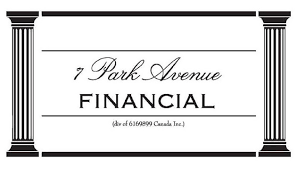|
Secure Your Business's Future with Small Business Finance Loans
Navigating the Canadian Market: Small Business Finance Loans Explained
Your Company Is Looking For Working Capital Solutions!
Your Financial Lifeline: Small Business Finance Loans in Canada
You've arrived at the right address! Welcome to 7 Park Avenue Financial
Financing & Cash flow are the biggest issues facing businesses today
Unaware / Dissatisfied with your financing options?
Call Now! - Direct Line - 416 319 5769 - Let's talk or arrange a meeting to discuss your needs
Email - sprokop@7parkavenuefinancial.com

WORKING CAPITAL SMALL BUSINESS FINANCE LOAN SOLUTIONS
Introduction
Small business finance loans in Canada play a pivotal role in the growth and sustainability of entrepreneurial ventures across the country - That should mean that your company has access to all the working capital you need to both run and grow your business.
Understanding Small Business Financing Options
At 7 Park Avenue Financial, we believe that it is not impossible, but the business owner and his or her financial manager must have a solid understanding of the options and your company's ability to qualify for and execute on the option or options that make sense. Note that in some cases, it might make sense to cobble together more than one option to achieve that 'cash flow nirvana' you are looking for.
The Universality of Cash Flow Needs
The business reality is that cash flow doesn't discriminate - both companies in looking for SME COMMERCIAL FINANCE solutions, all the way up to the largest corporations need access to cash flow options. The challenge for smaller firms is that business finance loans are often more limited to smaller companies. So it's, therefore, important to know what those options are!
Assessing Your Working Capital & Small Business Financing Needs / Key Elements of Working Capital Assessment
Two key elements of your first step to what we call 'working capital assessment' are your gross margins and your turnover. That’s the big problem we have with textbook/academic solutions to working capital - they point you to the textbook calculation - and give you a formula which essentially has you subtracting current liabilities from current assets, and voila! The inference is you have working capital. However, our clients have never paid a supplier or completed a company payroll with a ratio!
Many firms have an 'inventory component' to their business - These companies are typically non-service type firms, which often are less capital-intensive.
Focusing on Asset Turnover
To properly assess your working capital needs focus on understanding your turnover - how much inventory do you carry, what are the days outstanding in inventory, and as importantly, or more importantly, are your receivables turning over.
Business experts tell us that for many firms 80% or so of the total of all the business assets you have are tied up in A/R, inventory, and, on the other side of the balance sheet let’s not forget accounts payable.
Empowering Your Financial Success
It is possible to have financial business financing success based on your newfound knowledge and analysis of your cash flow and asset turnover.
Solutions To Business Finance In Canada
Canadian business financing solutions to small business finance loans really revolve around a couple of viable solutions. Typically, in our experience Canadian chartered banks can't satisfy your business working capital needs - if only for the reason that they rarely finance inventory and require significant merit in your overall financials, profitability, external collateral, personal creditworthiness, etc.
Exploring Viable Financing Options
There are very viable options that have the potential for a 100% turnaround in cash flow:
Asset-Based Line of Credit (ABL)
A total working capital solution can be achieved by a working capital finance solution such as a non-bank asset-based line of credit. This solution monetizes your accounts receivable and inventory into one borrowing facility. This is commonly called an 'ABL,' namely an asset-based line of credit that provides high leverage margining on all your business assets.
Securitization and Purchase Order Financing
Other solutions, still as viable, yet somewhat misunderstood are securitization and purchase order financing of new contracts and orders. (Your suppliers are paid directly for the orders you have in hand - what could be better than that?)
Factoring and Invoice Discounting
One of the most active types of 'instant small business financing.' Finally, coming up the road at lightning speed is factoring and invoice discounting. We mention them last but they are probably the most popular method, gaining traction every day. Our favourite is confidential invoice financing, allowing you to control your financing.
Recommended A/R Small Business Financing? Confidential Receivable Financing
Confidential Receivable financing, allows your company to bill and collect your invoices in a normal fashion, turning current and future sales into instant cash flow.
The Canada Small Business Financing Program - Government Loans In Canada
The Canada Small Business Financing Program (CSBFP) is a federal government-supported small business loan initiative aimed at reducing lending risks for small businesses by partnering with banks and credit unions. This partnership makes it easier for small businesses to secure loans from these financial institutions for eligible assets and other needs. Companies with gross annual revenues less than 10M can apply under the government guarantee program.
Over the past decade, the CSBFP has provided more than 53,000 loans totalling $10 billion to small businesses!
Funds obtained by Canadian small businesses through the CSBFP can be used for two types of borrowing: term loans and lines of credit. Term loans can finance various purposes, including eligible purchases of assets or improvement of commercial properties, acquisition of new or used equipment, leasehold improvements, intangible assets, and working capital needs. Examples of what can be financed with term loans include vehicles, restaurant equipment, leased property renovations, computer systems, production equipment, and franchise acquisition.
Lines of credit under the CSBFP are designed to cover working capital expenses required for day-to-day business operations.
The primary advantage of the CSBFP is that the government's backing of loans increases the chances of approval for small businesses seeking term loans with lump sum payments on a monthly basis as a tailored repayment schedule or lines of credit.
The maximum loan amount available to borrowers through the CSBFP is $1.15 million, with specific allocations:
- Up to $1,000,000 for term loans with an amortization period, with a maximum of $500,000 for leasehold improvements / real property improvements for lease property, and equipment purchases, and $150,000 for intangible assets and working capital.
- Up to $150,000 for lines of credit.
Interest rates for term loans are determined by the lending financial institution and can be either floating or fixed. Floating rates are capped at the lender's prime lending rate plus 3%, while fixed rates are capped at the lender's single-family residential mortgage rate plus 3%. For lines of credit, the interest rate cap is the lender's prime lending rate plus 5%. A small registration fee is required upon loan approval. A limited personal guarantee is required for these SBL loans.
Farming businesses come with a separate business loan solution via a similar program.
Community-Based Microloans
In certain Canadian communities, microloan programs exist to support local small businesses. These programs often operate on a smaller scale and are community-driven, offering low-interest or interest-free business loans
Key Takeaways
-
Financing Options: Understanding various financing avenues is crucial. Explore loans, lines of credit, and grants to access capital.
-
Creditworthiness: Assessing your creditworthiness is vital. A strong credit score opens doors to favourable loan terms.
-
Business Plan: Crafting a comprehensive business plan is essential. Lenders need to see a clear roadmap for success.
-
Collateral: Be aware of collateral requirements. Some loans may require assets as security.
-
Interest Rates: Interest rates impact repayment. Low rates minimize costs and enhance profitability.
-
Loan Terms: Loan terms dictate repayment schedules. Longer terms offer flexibility but may accrue more interest.
-
Government Programs: Explore government-backed programs. They often provide favourable terms and support for small businesses.
-
Cash Flow Management: Effective cash flow management ensures you can meet loan obligations and sustain operations.
-
Application Process: Understanding the loan application process streamlines your efforts and increases approval chances.
-
Risk Assessment: Assess potential risks associated with loans. Mitigate them to protect your business.
Conclusion: Expert Guidance for Your Cash Flow Needs
We have identified several ways to determine the need for proper business financing; we have outlined a number of solutions that will take the guesswork out of working capital. These loan and financing options are available with a bit of research and/or help from a trusted, credible and experienced Canadian business financing advisor.
Call 7 Park Avenue Financial who can provide you with timely and valuable assistance in your cash flow needs and small business funding solutions.
FAQ: FREQUENTLY ASKED QUESTIONS / PEOPLE ALSO ASK / MORE INFORMATION
What are the benefits of small business finance loans in Canada?
Small business finance loans provide essential capital for growth, helping you invest in expansion, hire staff, manage cash flow, and seize new opportunities.
How can I qualify for a small business finance loan in Canada?
Eligibility often depends on factors like creditworthiness, business plan, and collateral. Lenders also consider government-backed programs for easier access.
Are there government programs to support small business loans in Canada?
Yes, Canada offers various government programs for new or existing businesses with favourable terms, lower interest rates, and support for startups and growth-focused businesses.
What is the typical interest rate for small business finance loans?
Interest rates vary but generally range from 8% to 15%. Factors like credit history, loan amount, and lender influence the rate you receive. Merchant cash loans are lump sum installment loans and are easily accessible but come with higher rates.
How can I use a small business finance loan effectively?
You can use the loan for working capital, equipment purchase, marketing, expansion, and debt consolidation. Effective use enhances your business's sustainability and profitability.
What are the current economic trends affecting small business loans in Canada?
Economic trends may impact interest rates, demand for loans, and government programs. Stay updated for informed borrowing decisions.
Are there alternatives to traditional banks for small business financing?
Yes, alternative lenders, credit unions, and online platforms offer diverse financing options. Explore which aligns with your needs.
How does personal credit history affect a business loan application?
Personal credit history matters, especially for startups. A strong personal credit score can improve loan terms working capital costs and access to capital.
Can I apply for multiple small business loans simultaneously?
Yes, but be cautious. Multiple applications can impact your credit score and final credit approval.It's best to research and apply strategically.
What documents should I prepare when applying for a small business finance loan?
Commonly required documents include a business plan, financial statements, tax returns, and legal business documents. Each lender may have specific requirements.
What is the difference between a business line of credit and a term loan?
A business line of credit provides flexibility with revolving credit, while a term loan offers a lump sum with fixed payments. Choose based on your business's needs.
Can I use a small business finance loan to refinance existing debt?
Yes, debt consolidation is a common use for business loans. It can simplify payments and potentially reduce interest costs.
How long does it typically take to secure a small business finance loan in Canada?
The time varies but can range from a few days to several weeks. It depends on factors like the lender's processing time and your application's complexity.

' Canadian Business Financing With The Intelligent Use Of Experience '
STAN PROKOP
7 Park Avenue Financial/Copyright/2025

ABOUT THE AUTHOR: Stan Prokop is the founder of 7 Park Avenue Financial and a recognized expert on Canadian Business Financing. Since 2004 Stan has helped hundreds of small, medium and large organizations achieve the financing they need to survive and grow. He has decades of credit and lending experience working for firms such as Hewlett Packard / Cable & Wireless / Ashland Oil
|